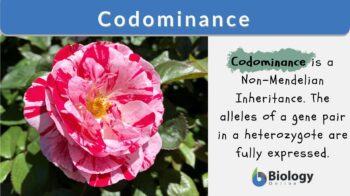
Codominance
n., [ˈkoʊˈdɑːmɪnəns]
Definition: alleles of a gene pair in a heterozygote are fully expressed
Table of Contents
Codominance Definition
Codominance is a form of inheritance wherein the alleles of a gene pair in a heterozygote are fully expressed. As a result, the phenotype of the offspring is a combination of the phenotype of the parents. Thus, the trait is neither dominant nor recessive. Codominance in humans is exemplified by individuals with type AB blood. A person inheriting the alleles IA and IB will have a type AB blood because IA and IB are codominant and therefore will be expressed together. Other codominance examples are the white-spotted red flower in plants and the black-and-white-coated mammals.
Etymology: the term codominance is the combination of co- means “together” and dominance. Variant: co-dominance.
Let’s talk about codominance! Join our Forum: What is the key to the recognition of codominance? Tell us what you think!
Alleles and Genes
An allele is a variant of a gene. Alleles come in pairs. Each pair has own spot (locus) in the chromosome and controls the same trait. The allele that is expressed is described as dominant whereas the allele that is masked is described as recessive.
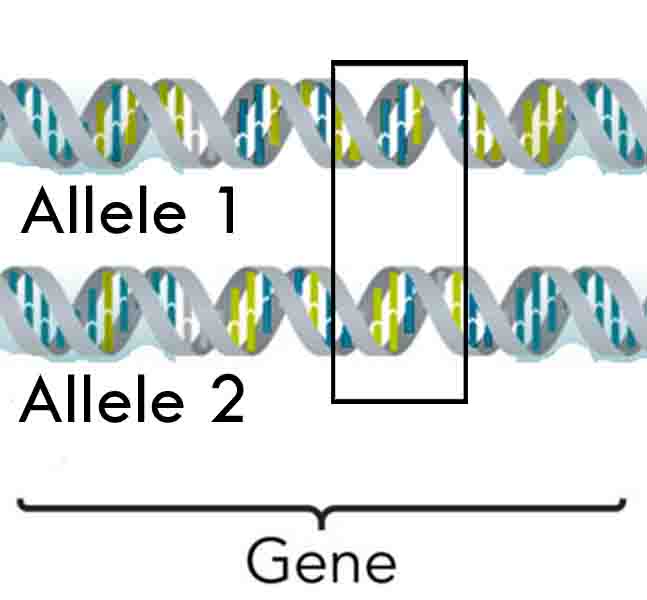
In order to understand codominance, an overview of the basic concepts is essential. A gene is the fundamental, physical, and functional unit of heredity. It is comprised of nucleotides responsible for the physical and heritable characteristics of an organism. It specifies the structure of a particular protein or of an RNA molecule.
A variant of a gene is referred to as an allele. Alleles come in pairs. The pair of alleles occupies a similar locus (I.e. a spot in the chromosome) and they control the same trait. The allele that is expressed or masks the effect of the other allele is described as dominant. Conversely, the allele whose effects are not manifested or are masked by the dominant allele is described as recessive.
Punnett Square
In order to determine if a trait is codominant, a tool called Punnett square may help. Punnett square helps to show all possible allelic combinations in a test cross. It determines the possible genotypes of the offspring. It is a diagram in grids and letters to represent alleles. An uppercase letter (e.g. A) denotes a dominant trait or genotype and a lowercase denotes a recessive trait or genotype (e.g. a).
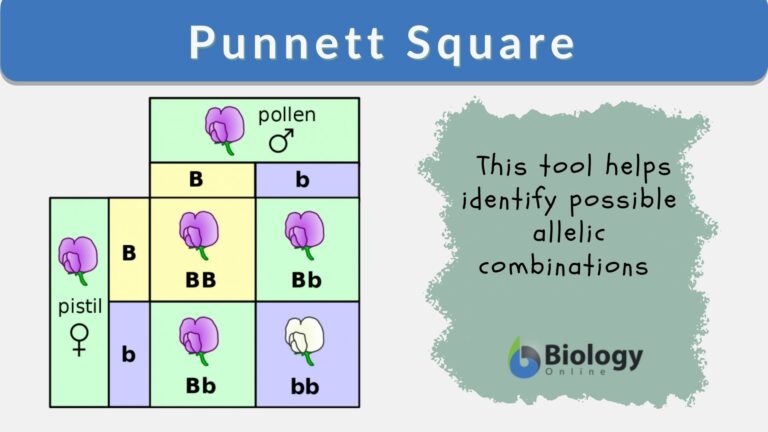
Homozygosity and Heterozygosity
The genotype is a major factor that determines the phenotype (physical or biochemical characteristics) of an organism. In the given example above, there could be three possible genotypes: AA, Aa, and aa. And based on the nature of these alleles, the condition may be homozygous or heterozygous. Homozygosity is the condition wherein the alleles on the locus are the same or identical (e.g. AA or aa). In contrast, heterozygosity is the condition wherein the alleles occupying the same locus are different (e.g. Aa). AA genotype is homozygous dominant whereas Aa, heterozygous dominant. The aa genotype is an example of homozygous recessive.
Dominance
In a general sense, dominance pertains to the state of being “dominant” or “supreme”. In genetics, dominance pertains to a gene or allele expressed over the other genes or alleles. There are three major forms: complete dominance, incomplete dominance, and codominance.
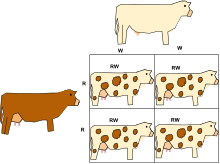
When an individual inherited two dominant alleles (e.g. AA) or inherits at least one dominant allele (e.g. Aa), that individual will show the trait because of the presence of the dominant allele. In contrast, the individual lacking the dominant allele (e.g. aa) means that the other trait will manifest since there is no dominant allele to mask it. This is what occurs in the complete dominance and the resulting pattern conforms to the Mendelian inheritance. (1, 2) The dominant allele will be expressed while the recessive allele will be suppressed. Hence, the heterozygous organism (Aa) will have a trait similar to the homozygous dominant (AA). Conversely, those that do not conform exemplify the non-Mendelian type of inheritance.
Non-Mendelian Inheritance
In non-Mendelian inheritance, the resulting phenotype of the offspring is different from the phenotypes of either parent. Codominance and incomplete dominance are examples. (2) In codominance, the alleles of a gene pair in a heterozygote are fully expressed. This results in offspring with a phenotype that is neither dominant nor recessive.
As for the incomplete dominance definition, this form of inheritance occurs when the phenotype is intermediate to the phenotype of the parents. (2) The dominant allele is only partially expressed and the resulting heterozygous offspring will show a phenotype that is intermediate to the phenotype of the parents. An example of incomplete dominance is when a male white flower parent is crossed with a female red flower the offspring will be a plant that will soon bear pink flowers.
Codominance is different from incomplete dominance in the way that the former has both alleles manifesting the phenotypes whereas the latter produces an intermediate phenotype.
Got a question about codominance? Join our Forum: What is the key to the recognition of codominance? Share with us what you think.
Examples
Below are some of the examples of codominance.
Type AB blood
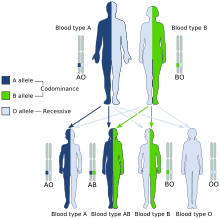
In the ABO blood type system in humans, blood type AB is an example of codominance. It implies that both dominant alleles are present and expressed together. A genotype of IAIB would result in H antigens with both N-acetylgalactosamine and galactose.
Type AB blood of the ABO blood type system is an example of codominance in humans. (3) The red blood cells have antigens on their surface. One of these antigens is the H antigen that is controlled by three alleles: IA, IB, and i. Both IA and IB are dominant alleles that when expressed produce enzymes that modify the H antigen. IA particularly adds N-acetylgalactosamine’’ whereas IB adds galactose to the H antigen. (4, 5) With ii alleles, thus lacking the dominant alleles, there would be no such modifications on the H antigen on the red blood cells. A genotype of IAIA or IAi would result in H antigens with N-acetylgalactosamine on the red blood cells – a trait indicating type A blood. A genotype of IBIB or IBi would result in H antigens with galactose – a trait indicating type B blood. A genotype of IAIB would result in H antigens with both N-acetylgalactosamine and galactose. This indicates type AB blood. Conversely, a genotype of ii means lacking such modifications on the H antigen and an indication of a type O blood. In codominance, blood type AB implies that both dominant alleles are present and expressed together.
Black and white coat
In other animals, codominance is exemplified by a mix of coat colors in a progeny of parents with different coat colors. For example, a cross between a black-furred male dog and a white-furred female dog could produce offspring with a black-and-white coat. This means that the color coat traits of the parents are codominant as both were expressed together in the progeny.
White-spotted red flower
Codominance is exemplified by a plant that bears flowers with two distinct color phenotypes. For instance, a white-spotted red flower could be caused by a cross between a red flower and a white flower. The alleles for the red and white color phenotypes mean that they are codominant.
Codominance vs Polygenic Inheritance
Take note that codominance is a different concept from polygenic inheritance. While both of them do not conform to the Mendelian inheritance, they differ in the way that in polygenic inheritance multiple genes are involved to produce cumulative effects. (6) In codominance, different alleles of a single gene affect the resulting trait. Examples of polygenic traits in humans are height, weight, skin color, and eye color.
READ: Dominance – Tutorials
Get in touch with our community. Join our Forum: What is the key to the recognition of codominance? Be a part of us!
Discover more types of non-Mendelian inheritance such as incomplete dominance and codominance in this vid.
See also
References
- Intro to Genetics. (2019). Retrieved from Estrellamountain.edu website: https://www2.estrellamountain.edu/faculty/farabee/biobk/BioBookgenintro.html
- Mendelian Genetics. (2019). Retrieved from Ndsu.edu website: https://www.ndsu.edu/pubweb/~mcclean/plsc431/mendel/mendel1.htm
- Morgan, W. T. J. & Watkins, W. M (1969). “Genetic and biochemical aspects of human blood-group A-, B-, H-, Le-a- and Le-b-specificity”. Br. Med. Bull. 25 (1): 30–34.
- McLain, D.K. (1995). Genetics, Diversity, and the Biosphere. AudioText. Retrieved from https://books.google.com.ph/books?id=LnqiDwAAQBAJ
- Watkins, W. M. (1980). “Biochemistry and Genetics of the ABO, Lewis, and P Blood Group Systems”. In Harris, H.; Hirschhorn, K. (eds.). Advances in Human Genetics. 10. New York: Plenum. pp. 1–136.
- Gene Interactions. (2019). Retrieved from Estrellamountain.edu website: https://www2.estrellamountain.edu/faculty/farabee/biobk/BioBookgeninteract.html
© Biology Online. Content provided and moderated by Biology Online Editors.
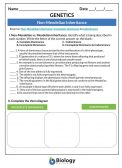
|
NON-MENDELIAN INHERITANCE WORKSHEET
This worksheet will test the student’s aptitude on Non-Mendelian inheritance. The first part will test the student’s comprehension of complete dominance, incomplete dominance, and codominance. The second part is a practice on logical relations between incomplete dominance and codominance through a Venn diagram. Subjects: Genetics & Evolution |




